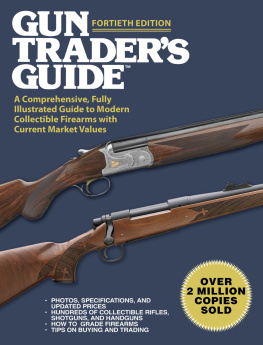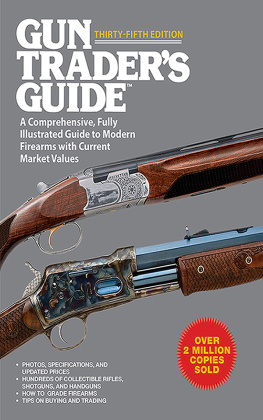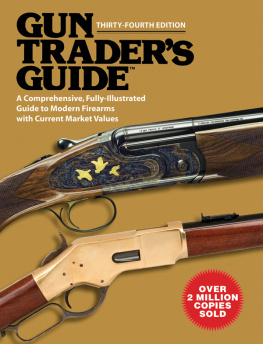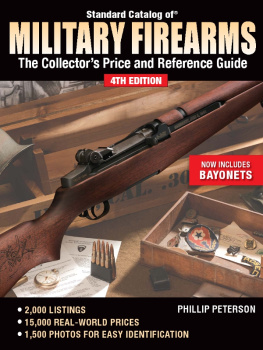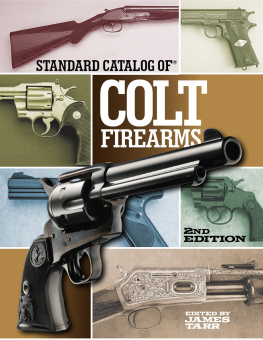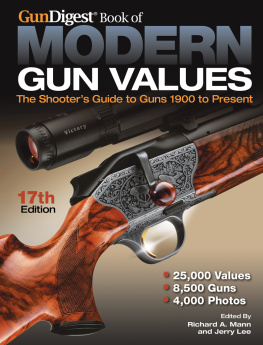Thank you for purchasing this Gun Digest eBook.
Sign up for our newsletter and receive special offers, access to free content, and information on the latest new releases and must-have firearms resources! Plus, receive a coupon code to use on your first purchase from GunDigestStore.com for signing up.
or visit us online to sign up at http://gundigest.com/ebook-promo
Table of Contents
Arms Pricing & Reference
Introduction
Welcome to the 18th Edition of the
Gun Digest Book of Modern Gun Values. In this book you will find historical data, photographs, detailed descriptions, technical information, and estimated values of virtually every handgun, rifle, and shotgun of the modern smokeless-powder era, generally defined as those manufactured or imported into the United States since 1900. As always, firearms trends continue to ebb and flow with each passing year and innovation, and here are some of the latest observations from the world of firearms. The tactical boom has faded. Specifically for AR-type guns.
They still sell, but after eight years of high demand the market is saturated with new product. All of the manufacturers have been shipping rifles as fast as they can build them. Unfortunately, the pool of eager buyers has dwindled as many have completed their acquisition phase. So inventories at distributors and gun retailers are full. There are currently deals from several Internet retailers with brand name, base-model M-4 clones priced just over $600 retail. But, the retail market for new polymer-frame striker-fire pistols continues to grow.
Glock seems to dominate the civilian and law enforcement markets. The values of most mass-produced pistols have not changed much in the last few years, and base-model pistols from most of the major manufacturers still hover in the $400 to $600 range. So, prices for used models will be lower, but they have not been around long enough to become collectible yet. Collectible is the word that drives the used gun market. Almost everything made 15 or so years ago is now considered a collectible. There are not that many true gun collectors out there these days, but tracking collector demand and buying habits is really what having price listings in price guides is all about.
Often gun owners will begin by looking at used or discontinued models after enjoying their new polymer-frame pistol or AR-style rifle. As they encounter other shooters at the range, gun shows or Internet discussion boards, they are exposed to the classic guns, whatever they happen to be. That is when many become collectors without ever considering themselves gun collectors. They want to learn about the firearm they are interested in. It goes beyond just wanting to know if a gun would function reliably and be accurate enough for how they intend to use it. They start to like guns.
No longer just a tool. A want, not a need. They start asking the same questions that a collector would: Is this original? When was it made? What is the story behind it? Many guns and gun manufacturers have interesting stories or historical connections behind them. For whatever reasons they have, these casual gun buyers are now applying collector concepts into their shopping habits. Thus, most discontinued guns are climbing in value. Some cases are common knowledge, such as the Colt Snake revolvers Python, Diamondback, Anaconda, Viper, etc.
I have seen some new in the box 1970s vintage nickel 212-inch barreled Pythons sold for more than $8,000. That does not mean I would price that gun at $8,000 in the listings. Such extremes are unique to the high-end auction market. Smith & Wesson large-frame revolvers are climbing fast as well. But, other lesser known manufacturers have now crossed over into collectible status. Modern Gun Values profiles the products of all major U.S. gun manufacturers and importers and, in most cases, every model variation that appeared in the companys catalogs. gun manufacturers and importers and, in most cases, every model variation that appeared in the companys catalogs.
Not every prototype or projected new introduction is included, such as the occasional model that was shown at trade shows, but, for whatever reason, never went into production. Still, for their historical value, some prototypes or models with very limited runs are listed. This book is primarily designed for the gun owner or potential buyer who wants a handy source for the estimated values and descriptions of the models likely to be seen in gun stores, at gun shows, or auction sites. Some military-issue weapons are included but, for the most part, Modern Gun Values focuses on firearms produced for the general civilian market. We also limit listings for made-to-order custom firearms, especially those produced by one- or two-man shops that turn out only a handful of guns each year. For those interested in a wider range of firearms or a more in-depth look at specific categories, we call the readers attention to these other Krause publications: Standard Catalog of Firearms, Flaydermans Guide to Antique American Firearms, Standard Catalog of Military Firearms, and Gun Digest Buyers Guide to Tactical Rifles.
The company also publishes books that focus exclusively on the firearms of a specific manufacturer, such as Standard Catalog of Colt Firearms, Standard Catalog of Browning Firearms, and similar titles covering the guns of Winchester, Smith & Wesson, and others.
HOW TO USE THIS EDITION
Modern Gun Values is divided into four major sections Handguns, Rifles, Shotguns and Commemoratives. Within each of these sections the individual firearms entries are listed in numerical model, then alphabetical, order. (A valuable reference section is also included in the back pages of this book.) Readers can locate a particular gun in three ways: by browsing through the sections and alphabetical manufacturers listings; by consulting the comprehensive GUNDEX index section; or by consulting the Manufacturers Directory that precedes each respective section of the book. We have attempted to improve the illustrations shown in this book wherever possible and especially in those cases in which illustrations help the reader to differentiate between similar models. We have established a three-tiered pricing approach for each firearm based on the six NRA Modern Condition Pricing Standards: New, Perfect, Excellent, Very Good, Good and Fair.
Each firearm has been evaluated to determine which three NRA standards most accurately reflect the condition in which the particular firearm is most likely to be found on the used market; the firearm is priced accordingly. For example, firearms currently on the retail market, or manufactured in the last four years, will most always be found in New or Perfect condition on the used market, while most older firearms will rarely be found in any condition exceeding Very Good. The three pricing levels we provide reflect current observations of prices seen at gun shows, in the gun shops or in the various periodicals, dealers catalogs or at auction sales. There are three primary factors that are key to establishing a firearms value. These are demand, availability and condition.




